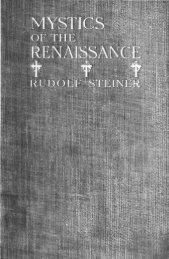The Supreme Doctrine - neo-alchemist
The Supreme Doctrine - neo-alchemist
The Supreme Doctrine - neo-alchemist
You also want an ePaper? Increase the reach of your titles
YUMPU automatically turns print PDFs into web optimized ePapers that Google loves.
Chapter Fourteen<br />
EMOTION AND THE EMOTIVE STATE<br />
CLASSICAL psychology, in studying emotivity, misunderstands an<br />
extremely important distinction from the point of view of the inner<br />
evolution of man. It certainly describes this 'movement of the soul'<br />
which wells-up as a result of an impulse from the outside world, in response<br />
to an image consciously perceived, a movement of anger, of love, of remorse,<br />
etc.... But the play of emotion, in us, is not confined to that. I often feel the<br />
existence in me of a durable emotive 'state' concerning which I see clearly<br />
that it is not released in me by images that I have in my head at that moment;<br />
I am more or less gloomy, for example, while thinking of a thousand<br />
harmless matters. If then I demand what images have brought me this state,<br />
sometimes I do not find any, but often also I find the worry which lies<br />
underneath my surface associations and which releases my sombre state of<br />
mind. When I was not thinking about it my worry was motionless in my mind<br />
(fixed idea) and released a durable emotive 'state' that seemed motionless.<br />
Now that I think of my worry, when I evoke an imaginative film about it,<br />
emotive movements are produced in me, like those of which we spoke at the<br />
beginning; but I feel that there persists beneath these movements the<br />
motionless emotive state, and I feel that this state was certainly in relation<br />
with the worry that I have just brought up to my surface mind.<br />
Inner experience shows me then that, under dynamic emotions, there<br />
exists a static emotion. But how is one to understand this last? Its name even<br />
seems paradoxical; emotion implies movement; can one speak of static<br />
movement? In order to resolve this contradiction and show how the emotive<br />
state can be at once a movement and an immobility, it will suffice to compare<br />
those 'movements of the soul' which are emotions with the movements of the<br />
body which are our muscular contractions. If a muscle can contract<br />
dynamically in a contraction it can also contract statically in a spasm, or<br />
cramp. Emotions connected with conscious images are psychic contractions,<br />
the emotional state connected with subconscious images is a psychic spasm.<br />
121




